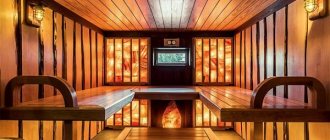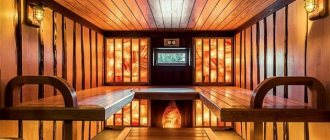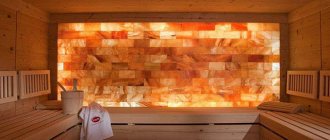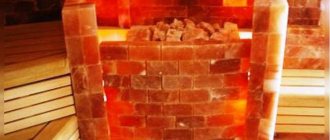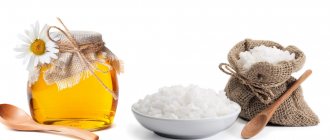Types of Himalayan salt
Salt is the cheapest means for bathing procedures. Several types of salts can be used in a steam bath:
Himalayan
You can buy it in a specialized store for baths or saunas, in hardware or perfume departments of household stores. It enriches the body with barium and sodium, the properties increase many times when heated.
Important! There are contraindications for use: renal failure, cancer, glaucoma, tuberculosis, blood diseases.
It is a valuable mineral formed during centuries of volcanic activity and mined in the Himalayan mountains of the Punjab province of Pakistan. Salt, which contains more than 90 useful chemical elements, is extracted manually, so it is recognized as one of the most environmentally friendly substances used in everyday life.
Depending on the inclusion of iron oxide in the substance, salt is classified into 3 types: pink, red and black. Pink and red are especially popular.
In a Russian steam room or sauna, Himalayan salt can be used in the form of:
- bricks - they are used to lay out small walls in the steam room;
- tiles - cover the walls;
- pebbles (from a pea to a walnut in size) - placed on the stove and sprinkled with water to release steam;
- sand from medium and coarse salt - used to scrub the body or prepare a solution for wiping.
Stone
The usual rock table salt, which is used by every housewife for cooking. Its peculiarity lies in its fine grinding and possible mineral additives. It is necessary to monitor the composition of the substance: it should not contain fragrances or harmful chemical additives.
Marine
It is large, enriched with elements characteristic of sea water, which means it is very close to the composition of blood and therefore the use of sea salt is very useful. Effective for treating skin diseases, removes toxins, heals wounds, stimulates sweat production.
Himalayan salt: what is it and what makes it unique
During the formation of continents, sections of the bottom of the world's oceans rose to the surface, and the process of formation of mountains was underway. Marine sedimentary rock was enriched with minerals from magma pouring out of volcanoes. As a result, deposits of Himalayan salt were formed. The largest deposit is located in Pakistan at a distance of 300 km from large settlements.
The crystals are extracted by hand and dried in the open air without the use of chemicals.
The absence of harmful impurities and the ecological purity of the mining area make Himalayan salt healthy and unique.
Varieties of mineral
A similar mineral is mined in special caves and comes in 3 types:
- Black;
- Pink;
- Orange with a reddish tint.
The most popular is pink salt. The main countries for mineral extraction are Kyrgyzstan, Poland, Ukraine, Pakistan.
The largest deposit was discovered in Pakistan, which was named after the great commander Alexander the Great. Extraction is carried out exclusively by hand without the use of special equipment that can damage the fragile structure of the mineral.
Salt cave effect in your own steam room
There are several options for integrating a natural mineral into the arrangement of a bath complex. In the steam room, the walls and floor are made of monolithic salt blocks. Under the influence of a humid environment and high temperature conditions, a microclimate with a high content of sodium and chlorine ions is formed in the internal space. As a result, a sufficient concentration of active substances is created, which causes the effect of the notorious salt cave.
Installation of mineral blocks is carried out using special compounds. During construction work, silicate glue - liquid glass - or a two-component compound can be used. The wall can be erected on suspensions using a supporting frame made of lumber. When arranging a structure, spotlights are often introduced in the form of built-in LED devices. The result is an impressive composition with a mesmerizing sparkle of crystals.
Principles of creation and nuances of operation of a steam room with the effect of a salt cave:
- Using monolithic mineral blocks, one or more walls are laid out. It is worth considering that the durability of the structure depends on the intensity of bath procedures;
- the floor, made of salt blocks, is actively subject to destruction. The walls, if you do not overdo it with steam, will last quite a long time;
- It is enough to decorate one wall with monolithic blocks to provide the effect of a salt cave on a limited budget.
The good thing about this method is that the walls and floors made of salt monoliths work on their own: active compounds are released, the air in the steam room is saturated with chlorine and sodium ions, creating a favorable microclimate with a healing effect.
Beneficial properties and healing effects of Himalayan salt
Whatever the quality, Himalayan salt is used, due to its environmental purity and the content of a complex of minerals, it has a healing effect and relieves diseases:
- genitourinary system;
- mouth, throat;
- heart, blood vessels;
- oncological;
- joints;
- skin;
- hypertension;
- bronchi and lungs;
- organs of the digestive tract.
Additionally, Himalayan salt:
- speeds up metabolism;
- performs a cleansing function, removes decay products;
- strengthens the immune system;
- relaxes the muscle frame;
- relieves nervous tension, eliminates the effects of stress;
- has a beneficial effect on the structure and relief of the skin;
- maintains water-salt balance;
- copes with insomnia;
- eliminates chronic fatigue syndrome;
- heals wounds, cleanses the dermis of acne;
- stimulates brain activity.
The healing properties of salt are revealed under the influence of high temperatures. Negative ions are released into the air, destroying pathogens.
Entering the blood through the respiratory tract, microparticles of minerals have a healing effect.
The benefits of pink salt when used in baths and saunas are as follows:
- Salt helps get rid of chronic rhinitis, reduce inflammation in the bronchi, and cleanse the lungs of stagnant mucus. Clean, disinfected air is beneficial for asthma patients. With regular visits to baths and saunas using Himalayan salt, the frequency of attacks decreases and the severity of allergic reactions decreases.
- The blood is enriched with oxygen, which is necessary for the normal functioning of internal organs.
Hot water with Himalayan salt has properties similar to water from natural hot springs.
- In a bathhouse or sauna, under the influence of hot steam, blood circulation accelerates, pores open on the skin, and ions of trace elements penetrate the dermis faster. The body is detoxified.
- Steam with particles of Himalayan salt inhibits the development of colds in the initial stages and is a prevention of infectious diseases.
- Replenishment of missing minerals - potassium, calcium, fluorine, iodine, copper, iron - normalizes hematopoiesis, brain activity, and stabilizes blood pressure. The condition of hair, nails, and skin improves.
- Salt triggers metabolic processes that eliminate digestive disorders. Sclerotic plaques and salt deposits in the joints and spine are destroyed.
Water charged with negative ions affects the psycho-emotional state and improves mood.
By strengthening the immune defense, bath procedures have a restorative, healing, and rejuvenating effect on the body.
Should I give up salt?
Giving up salt is one of the first stages of losing weight and switching to a healthy lifestyle. The harm of normalized salt intake is the most useless and inveterate myth of nutritionology.
Potassium is the main ion of cells, sodium is the main ion of blood. These elements are responsible for salt balance and enter the human body only with certain foods.
If the concentration of sodium and potassium is in harmony, then:
- the liquid is evenly distributed throughout the body;
- transport functions are improved;
- nervous activity is harmonized;
- the muscular corset and skeletal system are supported.
Microelements are needed by the body in certain quantities. The sodium to potassium ratio should be between 1:2 and 1:4. What is the rationale for this particular balance? In prehistoric times, our ancestors served as hunters and gatherers of plant foods. Sodium appeared extremely rarely in the diet of people of that time, so the body learned to synthesize it on its own. Potassium, on the contrary, was fully supplied with food, so there was no need to preserve it. The diet and pace of human life have changed significantly. We have unlimited access to food, and any discrepancy between micro- and macronutrients can be balanced with the help of medications.
A healthy adult needs 1 teaspoon of salt per day. With excessive physical exertion or serious fluid loss, the dosage is increased to 2-3 teaspoons.
Do not forget that salt comes into the body from vegetables, fish, meat, and not just from a teaspoon, which you divide into several meals. Excess sodium leads to edema and kidney and heart diseases.
To counteract the effects of sodium, a high concentration of potassium must be present in the diet. List of neutralizing products:
- filtered water (1 liter/1 gram sodium);
- dried apricots, raisins;
- bran;
- seeds;
- potato;
- cashews, almonds, peanuts, pine nuts, hazelnuts;
- prunes;
- beans, buckwheat;
- parsley, Brussels sprouts, porcini mushrooms.
Contraindications
The benefits and harms of Himalayan salt are incommensurable, but nevertheless there are contraindications for use. The list of conditions and diseases for which visits to salt baths and saunas are not indicated includes:
- viral and bacterial infections accompanied by fever;
- exacerbation of chronic diseases;
- liver and kidney pathologies;
- diabetes;
- decreased blood clotting;
- neoplasms of any etiology;
- epilepsy;
- tuberculosis.
Women are advised to refrain from procedures during menstruation.
Contraindications
The benefits and harms of Himalayan salt are incommensurable, but nevertheless there are contraindications for use. The list of conditions and diseases for which visits to salt baths and saunas are not indicated includes:
- viral and bacterial infections accompanied by fever;
- exacerbation of chronic diseases;
- liver and kidney pathologies;
- diabetes;
- decreased blood clotting;
- neoplasms of any etiology;
- epilepsy;
- tuberculosis.
Women are advised to refrain from procedures during menstruation.
The principle of operation of salt baths
When Himalayan salt crystals interact with hot water, a powerful compound is formed, which in terms of usefulness and effectiveness can be compared to natural hot springs. Due to the concentration of components vital for the human body in water, bath and sauna salt has a large number of medicinal properties. Thus, using water with a high alkaline content effectively fights viruses.
To better open pores, cleanse and get rid of toxins, use steam and hot water. Thanks to such bath procedures, hydrostatic pressure increases, which significantly improves the quality of blood circulation. Consequently, harmful substances are dissolved and removed from the body, the blood is saturated with oxygen, and nutrients enter the internal organs in greater volumes. There is also an improvement in metabolism and normalization of the gastrointestinal tract.
Content
- Himalayan salt: what is it and what makes it unique
- Beneficial properties and healing effects of Himalayan salt
- Contraindications
- Options for using Himalayan salt in baths and saunas
- Salt skin care and accessories
- Himalayan salt interior finishing options
- Adviсe
- Rules for procedures in a bath with Himalayan salt
- Conditions for obtaining the maximum beneficial (therapeutic) effect from visiting a bath with Himalayan salt
[ads-pc-2][ads-mob-2]
Rules for procedures in a bath with Himalayan salt
Tips for visitors to salt baths and saunas:
- Enter the steam room without makeup or perfume, since to obtain a healing effect, the air must be clean, ionized, without perfume impurities.
- Before visiting the premises, read the contraindications.
- Do not use accessories made of wool or cotton fabrics because lint gets into the disinfected, hypoallergenic air.
- It is prohibited to visit baths and saunas while under the influence of drugs or alcohol.
To enhance the effect of visiting salt establishments, perform the following procedures:
1. Scrubbing.
Rub the steamed body with a handful of Himalayan salt crystals soaked in water. Pay more attention to problem areas with a thick layer of subcutaneous fat and cellulite.
The orange peel effect will disappear or become less noticeable, depending on the stage of cellulite, after the fifth procedure.
The scrub has an anti-inflammatory and rejuvenating effect.
After 5-7 minutes of rubbing, go back into the steam room. Salt evaporation will penetrate faster through the skin and respiratory tract due to accelerated blood circulation and metabolic reactions.
2. Rubdowns.
Pink bath or sauna salt is used in the form of a solution. It is prepared from crystals and water mixed in equal proportions. If the face and neck are excluded during scrubbing, then rubdowns are carried out on any parts of the body. After 10-15 minutes, take a shower. This procedure reduces the symptoms of psoriasis, dermatitis, and joint diseases beyond the acute stage.
3. Using a broom.
The maximum effectiveness of Himalayan salt in the steam room is achieved by 10-minute exposure to a broom soaked in saline solution. To prepare it, take water and crystals in equal quantities.
Regardless of the procedures, between visits to the steam room, do not forget to replenish the water-salt balance with green tea, herbal infusions, and fruit drinks.
4. Massage.
Increases immunity, activates blood circulation, relaxes muscle fibers, massage performed after a steam room using small salt crystals or stones. This procedure helps fight cellulite and excess weight.
Options for using Himalayan salt in baths and saunas
How to use crystalline rock for maximum benefit? There are several ways to use Himalayan salt in baths and saunas.
Products made from crystalline rock are used as a building material for design. Soap and lamps are made from salt. Pebbles and salt are placed on the stove or placed in a bowl. Small crystals are used for cosmetic purposes by scrubbing the skin or dissolving in a basin of water for washing.
Salt blocks for baths
Himalayan salt in the form of blocks is used mainly for the construction of partitions. This material can also be effectively used for interior decoration. The thickness of salt blocks for baths and saunas is 100 mm. Thanks to the ability of a natural mineral to rejuvenate and heal the body, its popularity is only growing every year.
If you found this article useful, please like and subscribe to our channel. Don't forget to share information with your friends on social networks.
Floor
This could be laying a salt brick floor. Typically, unpolished elements are used for this purpose to roughen the surface. The floor arrangement includes a heating system. During the procedure, you can walk on the floor barefoot, as it does not heat up much, but has an evaporation effect. The skin of the feet is softened, and thanks to the rough surface, a massage with a peeling effect occurs.
Walls
Walls made of salt briquettes or slabs look very beautiful. Blocks can be no more than 10 cm thick with a sanded or untreated surface. They are used to lay out an independent partition or cover an existing wall. Salt tiles are also used for wall cladding. Due to the variety of colors, they create beautiful mosaics or patterns. Despite the fragile appearance of the blocks, they are characterized by high strength and density, but in conditions with low humidity.
The material can withstand heavy loads no worse than marble. In order for the wall to last as long as possible and maintain its healing properties, it is necessary to remove drops of water that have fallen on it, and the moisture level should not exceed 50%. The room must be ventilated frequently or equipped with a good ventilation system. Salt is not afraid of high temperatures, but on the contrary, they contribute to increased evaporation.
Salt pebbles
From salt you can create large smooth stones that look like pebbles. They are laid out on hot stones in the steam room before water is poured on them. This is the case if your stove is made of natural stone or has an anti-corrosion coating. Thanks to this, the salt will quickly evaporate along with its beneficial properties.
Pebbles are used to decorate the ceiling or walls, creating various inserts or patterns.
Decorative elements
Salt lends itself perfectly to cutting; you can use it to create decorative shapes and geometric elements to suit the design of your room. This could be a patterned panel on the wall or a lantern that will give the steam room not only comfort, but also soft light with a pink tint. To make a lamp, untreated stones are taken and a hole is made in their inner part. After switching on, the stone heats up and the air is ionized.
You can also place metal bowls with salt on the wall, and install special wooden baskets with random pieces of the useful component on the floor. Such compositions do not require special expenses, will last a long time and will benefit the body. Salt bricks are often used to build a screen around the stove.
Lampshade with salt
A lampshade is a good decorative element, but in a bathhouse it also serves a practical function. After all, the lighting device hidden behind the lampshade is used in conditions of high temperatures. So it should be:
- reliable in design;
- made from durable materials;
- moisture resistant;
- fireproof.
A lampshade made of wood with Himalayan salt will fit perfectly into the interior of the bathhouse.
Most often, lampshades are placed in the corners of the bathhouse directly under the ceiling or even close to it. There is a lighting fixture in the very corner, and between it and the wall of the lampshade, as can be seen in the photograph, there are Himalayan salt stones.
Materials from which you can make a lampshade for a bath:
- Tree. This option is good because the walls of the room are most often decorated with wood, and therefore the lampshade fits well into the interior. Also in favor of wood are its naturalness and environmental friendliness.
- Heat-resistant plastic, aluminum or stainless steel. These materials can be put on the same level, because they are slightly inferior to wood due to their chemical composition.
- Durable frosted glass. Used for decorative purposes, it provides endless design possibilities.
- Himalayan salt. Sometimes the lampshade is made from salt slabs. It's not cheap, but it's very effective.
Bowl of salt
The bowl is perhaps the most budget option. To bring it to life, you just need to buy a decorative bowl that would fit the interior of the bathhouse, place Himalayan salt inside in any form (pebbles are most often used) and hang it from the ceiling or wall mount. The materials are absolutely unlimited; the choice of appearance and shape of the bowl depends on the taste of the owner.
It is recommended to place the bowl close to the heat source so that the evaporation of the Himalayan salt is as intense as possible.
Decorative panel
This use of Himalayan salt is expensive, but very beautiful. It involves the creation of wall panels from salt stones and figured products. The panel is attached to the wall or, preferably, built directly into it.
The panel will look especially impressive if you place beautiful lighting inside the wall. After all, translucent salt will not only transmit light, but also scatter it beautifully, creating a unique atmosphere in the bathhouse
A Himalayan salt panel can have absolutely any shape and size.
The photographs show only two options for creating such decorative panels. Manufacturing methods are limited only by the author's imagination. You can also find ready-made panels made of Himalayan salt for sale.
Himalayan salt lamp
This method of using the mineral is quite unusual. The essence of such a lamp is a large salt stone, inside of which a light bulb is installed. Most often it is mounted on a stand, but there are also options that can be hung on the wall or hooked to the ceiling.
Lighting fixtures made from Himalayan salt are divided into 2 categories:
- natural (stone in its natural form);
- with decorative processing (some kind of pyramid or other figure is carved from stone).
It is advisable to install at least 3-4 such lamps to achieve maximum effect
For medicinal purposes, it is better to use natural lamps, because the fumes from them are more active.
